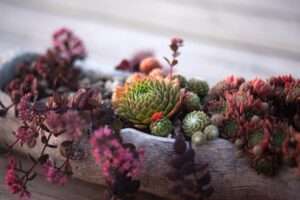Succulents are a type of plant that have adapted to survive in arid environments by storing water in their leaves, stems, and roots. They are known for their unique and often striking appearance, with thick, fleshy leaves and stems. Sun-loving succulents, as the name suggests, thrive in full sunlight and require several hours of direct sunlight each day to grow and thrive.
The Benefits of Full Sun Exposure for Succulents
One of the main benefits of exposing succulents to full sun is increased growth and blooming. Sunlight provides the energy that plants need for photosynthesis, the process by which they convert sunlight into energy. When succulents receive ample sunlight, they are able to produce more energy and grow at a faster rate. This can result in larger plants with more blooms.
In addition to increased growth, full sun exposure can also enhance the colors of succulents. Many sun-loving succulents have vibrant hues of red, orange, purple, and pink. When these plants receive adequate sunlight, their colors become more intense and vibrant. This can add a beautiful pop of color to any garden or indoor space.
Furthermore, full sun exposure can lead to stronger stems and leaves in succulents. The intense sunlight helps to strengthen the cell walls of the plant, making them more rigid and sturdy. This can help prevent the plant from becoming leggy or floppy, ensuring that it maintains its upright form.
Factors to Consider Before Exposing Succulents to Full Sunlight
Before exposing succulents to full sunlight, there are several factors that need to be considered to ensure their health and well-being.
Climate and temperature play a crucial role in determining whether a succulent can handle full sun exposure. Some succulents are more tolerant of high temperatures and intense sunlight, while others prefer milder conditions. It is important to research the specific needs of the succulent species you are growing and ensure that your climate is suitable for them.
Soil type and drainage are also important considerations. Succulents require well-draining soil to prevent root rot and other moisture-related issues. If your soil retains too much water, it may be necessary to amend it with materials such as sand or perlite to improve drainage.
Watering schedule is another factor to consider before exposing succulents to full sunlight. Succulents have adapted to survive in arid environments with infrequent rainfall, so they do not require as much water as other plants. It is important to establish a watering schedule that allows the soil to dry out between waterings, as overwatering can lead to root rot.
Common Sun-loving Succulent Varieties
There are many different varieties of sun-loving succulents, each with its own unique characteristics and care requirements. Some of the most popular sun-loving succulent varieties include Echeveria, Sedum, Crassula, and Aloe.
Echeveria is a genus of succulent plants that are native to Mexico and Central America. They are known for their rosette-shaped leaves and come in a wide range of colors, including green, blue, purple, and pink. Echeverias thrive in full sun and can tolerate drought conditions.
Sedum is another popular sun-loving succulent variety. They are known for their fleshy leaves and star-shaped flowers. Sedums come in a variety of shapes and sizes, from low-growing groundcovers to tall, upright plants. They are highly adaptable and can tolerate a wide range of growing conditions.
Crassula is a genus of succulent plants that includes the popular Jade Plant (Crassula ovata). They have thick, fleshy leaves and are known for their ability to store water. Crassulas are easy to care for and can tolerate full sun exposure, making them a popular choice for beginners.
Aloe is a genus of succulent plants that are native to Africa. They are known for their medicinal properties and are often used in skincare products. Aloes have thick, spiky leaves and produce tall flower spikes. They thrive in full sun and can tolerate drought conditions.
How to Prepare Succulents for Full Sun Exposure
Before exposing succulents to full sun, it is important to prepare them gradually to prevent sunburn and other damage. Here are some steps to follow:
1. Gradual acclimation: Start by placing your succulents in a location with partial sun or filtered light for a few hours each day. Gradually increase the amount of time they spend in direct sunlight over the course of several weeks. This will allow the plants to adjust to the intensity of the sunlight without getting burned.
2. Proper soil and potting: Ensure that your succulents are planted in well-draining soil that allows excess water to escape. Use a pot with drainage holes to prevent water from pooling at the bottom, which can lead to root rot.
3. Choosing the right location: When selecting a location for your succulents, choose an area that receives at least six hours of direct sunlight each day. Avoid placing them near windows with intense afternoon sun, as this can cause overheating and sunburn.
Tips for Properly Watering Sun-loving Succulents
Proper watering is essential for the health and well-being of sun-loving succulents. Here are some tips to keep in mind:
1. Watering frequency: Succulents have adapted to survive in arid environments with infrequent rainfall, so they do not require as much water as other plants. Allow the soil to dry out completely between waterings, and then thoroughly soak the soil until water drains out of the bottom of the pot.
2. Watering technique: When watering succulents, it is important to water the soil directly and avoid getting water on the leaves. Wet leaves can increase the risk of fungal diseases and sunburn. Use a watering can or a hose with a gentle spray attachment to water the soil around the base of the plant.
3. Use of fertilizer: While succulents do not require frequent fertilization, they can benefit from occasional feeding during the growing season. Use a balanced, water-soluble fertilizer diluted to half strength and apply it according to the instructions on the package. Be careful not to over-fertilize, as this can cause salt buildup in the soil.
Signs of Sun Damage in Succulents
Despite their ability to tolerate full sun exposure, succulents can still suffer from sun damage if they are not properly cared for. Here are some signs to watch out for:
1. Leaf discoloration: Sunburned succulent leaves may turn yellow, brown, or white. This is often accompanied by a softening or wilting of the affected leaves. If you notice any discoloration, move your succulent to a location with less intense sunlight and gradually reintroduce it to full sun.
2. Leaf drop: Excessive sun exposure can cause succulent leaves to become dehydrated and shriveled, leading to leaf drop. If you notice that your succulent is losing leaves, it may be a sign that it is receiving too much sun. Move it to a shadier location and adjust its watering schedule accordingly.
3. Stunted growth: If your succulent is not receiving enough sunlight, it may exhibit stunted growth. The stems may become elongated and weak, and the leaves may appear pale or stretched out. If this is the case, move your succulent to a location with more sunlight and adjust its watering schedule as needed.
How to Protect Succulents from Extreme Heat and Sunlight
While succulents are generally tolerant of full sun exposure, extreme heat and intense sunlight can still pose a risk to their health. Here are some tips for protecting your succulents during periods of extreme weather:
1. Use of shade cloth: If you live in an area with extremely hot summers, consider using shade cloth to provide some relief for your succulents. Shade cloth can be placed over the plants to filter out a portion of the sunlight and reduce the intensity of the heat.
2. Watering during cooler times of the day: During periods of extreme heat, it is best to water your succulents early in the morning or late in the evening when temperatures are cooler. This will allow the plants to absorb water without the risk of evaporation or scorching.
3. Moving plants indoors during extreme weather: If temperatures are expected to reach extreme highs or lows, it may be necessary to move your succulents indoors temporarily. Find a location with bright, indirect light and maintain their regular watering schedule until the weather conditions improve.
The Role of Soil and Fertilizer for Sun-loving Succulents
The type of soil and the use of fertilizer play important roles in the health and growth of sun-loving succulents.
Well-draining soil is crucial for succulents because it allows excess water to escape and prevents root rot. Succulents prefer a sandy or gritty soil mix that provides good drainage. You can create your own well-draining soil mix by combining equal parts potting soil, perlite, and coarse sand.
Fertilizer is not always necessary for succulents, but it can help promote optimal growth and blooming. Use a balanced, water-soluble fertilizer diluted to half strength and apply it during the growing season. Be careful not to over-fertilize, as this can cause salt buildup in the soil and damage the roots of the plants.
Conclusion: The Beauty and Resilience of Sun-loving Succulents
Sun-loving succulents are not only beautiful but also resilient plants that can thrive in challenging growing conditions. With their unique shapes, vibrant colors, and ability to store water, they add a touch of natural beauty to any garden or indoor space.
By providing them with the right amount of sunlight, well-draining soil, and proper watering, you can enjoy the benefits of increased growth, brighter colors, and stronger stems and leaves. Just be sure to monitor your succulents for signs of sun damage and take steps to protect them during periods of extreme heat or sunlight.
So why not give sun-loving succulents a try? With a little care and attention, you can create a stunning display of these resilient plants that will bring joy and beauty to your home or garden.
If you’re wondering whether succulents can thrive in full sun, check out this informative article on GirlsGist. It provides valuable insights and tips on how to care for succulents in sunny conditions. Whether you’re a beginner or an experienced gardener, this article will help you ensure that your succulents receive the right amount of sunlight for optimal growth. Don’t miss out on this helpful resource!

















Add Comment